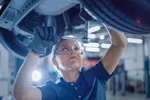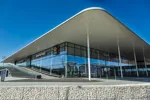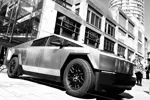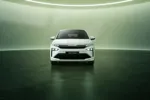The terrorist attacks of September 11 forced insurance companies to reappraise premiums and the level of cover available to businesses.
This, together with an explosion in showroom theft and vandalism over the past 12 months, has made it difficult for larger and prestige dealers to source adequate insurance cover without paying substantial premiums.
Many dealers have turned to surveillance technology to protect their premises combined with vehicle monitoring and tracking systems to protect their cars.
Giles Harridge, managing director of vehicle tracking services provider NavTrak, said: "Insurance premiums have rocketed and the nature of vehicle theft is changing - it's not just demonstrator vehicles, it's also cars that come in for a service.
"Since September 11, insurers are refusing to cover some companies, or pricing them out of business, if they don't protect their cars in some way."
Dealers are now installing tracking systems, like NavTrak, into their demonstrator cars in an attempt to reduce theft and trim insurance premiums.
The threat comes from two fronts: organised gangs of thieves and opportunist vandals causing damage and stealing CD/radios.
Police in the South-east set up a multi-force incident room over the summer to combat the upsurge in vehicle theft at dealers across the region.
Senior officers said Audi, Renault, Ford and Peugeot dealerships had been hit by "organised gangs" using transporters. They urged dealers to step up security, in particular ensuring that keys were protected.
More than half the cars stolen in the UK are taken with the keys, according to national statistics. This proportion is higher at the dealership, where key security can be inadequate.
In addition to the hundreds of thousands of pounds a year theft and vandalism costs dealers, they are also faced with a potential loss of reputation. Often, cars most at risk from theft are those brought in for service or repair, where the keys can be readily accessed.
NavTrak supplies a pro-active security card system, which effectively acts as a second key. If the car is started up without first using the security card, it alerts the NavTral control centre, which checks with the owner whether the car has been taken.
Despite a number of false alarms caused by forgetful drivers, the system is an important innovation to protect the car.
"There is no reason why a dealer should not install NavTrak on all their demonstrators - we have a special rate for this," said Mr Harridge.
He believes tracking systems, like NavTrak and rivals Trafficmaster and Tracker, make the cars more appealing to customers, who will also benefit from lower insurance premiums. "It could help the dealer to close the deal."
Surveillance security is increasing in popularity as a cost-effective deterrent to theft. CCTV can be successful, but only really works if it is monitored continuously so that the police are informed as soon as a thief breaks into the dealership.
Some dealers have chosen a two-tiered approach, combining physical security with remote site surveillance.
Developments in communications technology and improved access to ISDN lines make image transmission systems an affordable solution for many companies. The CCTV system links up to an off-site central monitoring service, which can inform police and even hamper the burglary by remotely operating bollards to block exits.
Staff can challenge intruders via a loudspeaker, activate sirens or trigger floodlights around the site.
HR Owen increased security at its Land Rover and Jaguar dealerships with a remote CCTV system installed by Image Surveillance Systems (ISS).
The system, linked to the ISS command centre in Colchester, is combined with BPT's Combipost hydraulically operated rising bollards to maximise security at the showrooms.
Neil Handley of ISS said: "BPT's automatic bollards are an essential part of HR Owen's security management system.
"Combining these with a remote site surveillance system provides a level of security and flexibility that is not possible using more conventional methods such as barriers with are unsightly."
The two-pronged approach - surveillance and tracking systems - is helping dealers to minimise the threat of theft, but it also offers profit opportunities for dealers. NavTrak, for instance, is installed in 1,500 cars, while the company is working with around 450 dealers, mostly franchised groups retailing prestige marques.
Dealers can expect to make £150 profit per unit, which takes two hours to fit. NavTrak sells the system for £449, plus £99.99 a month for airtime. The pro-active security system adds £50 to the box price, with a monthly charge of £14.99.
"Performance comes down to individual dealerships and their motivation to sell," said Mr Harridge. "But for any vehicle priced above £35,000, the dealer's conversion rate should be high. At the moment, that is often not the case because dealers tend to focus on the areas where they make most money, like finance."
NavTrak hopes to address the problem by working with dealers between the point of sale and delivery to sell the system. It also receives leads from insurance companies, but, admitted Mr Harrige, it is more difficult to sell the system after the car has been delivered.
"The dealer channel is important," he added.
The company is talking to manufacturers with a view to obtaining OEM approvals.
"Some manufacturers have put up barriers until they work out their telematics policies," said Mr Harridge. "We are progressing in these areas and we are already getting involved with OE fitment at the PDI stage."
He is confident of shortly announcing a "significant" deal with a manufacturer to supply first-fit units.















Login to comment
Comments
No comments have been made yet.